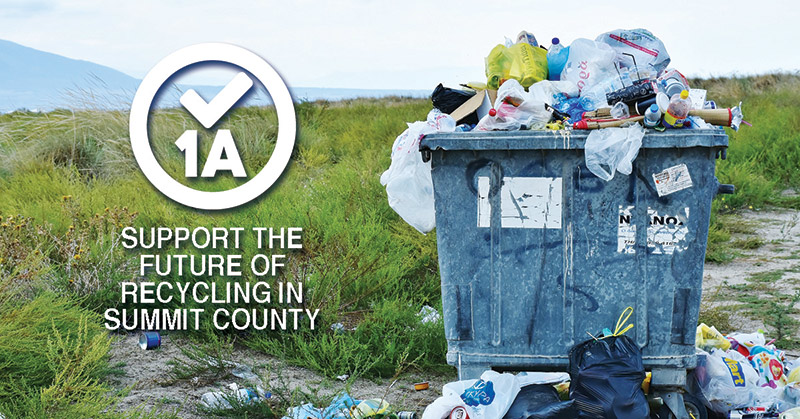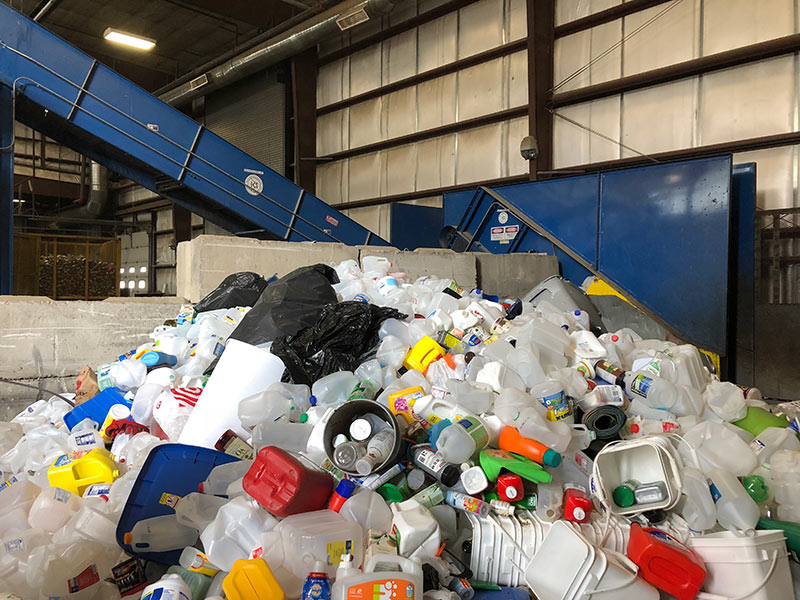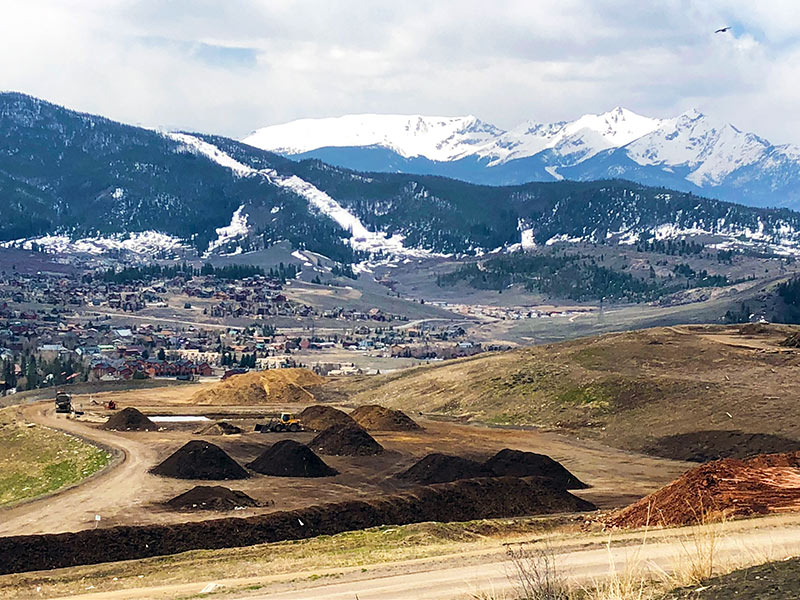
Dear Eartha,
I saw that recycling is up for vote this November through ballot initiative 1A. I already recycle and I don’t understand why it’s lumped with all these other things. Can you shed a little light? – Jared, Silverthorne
 Jared, thank you so much for your question — it’s so important to understand the issues and make your voice heard. I’m glad to hear that you are already taking an important step for our environment. However, the greater Summit County community needs to do better when it comes to recycling. A lot better.
Our diversion rate — the amount of waste we divert from the landfill through recycling and composting— is a mere 23 percent, while the national average is 34 percent. Additionally, the way we fund recycling in our community is pretty backwards. Let me explain.
A FUNDING CONTRADICTION
When trash is collected from your house and dumped at the SCRAP (the Summit County Resource Allocation Park, which is also known as the landfill) a tipping fee is incurred to put the trash into the landfill. These tipping fees subsidize the SCRAP’s recycling costs. The SCRAP’s recycling programs operate at a $500,000 annual deficit and need these trash tipping fees to help fund recycling.
As we increase recycling, we create less trash. That means fewer loads of trash, fewer tipping fees paid and decreased funding for recycling. That’s a problem.
To find a solution to this mess, a Zero Waste Task Force met back in early 2017. The group included members of local town and county governments, representatives from some of our county’s largest businesses and waste producers, and engaged citizens. An independent waste consultant led the meetings.
The group reviewed all kinds of options to create a sustainable source of recycling funding that wasn’t reliant upon trash tipping fees. And ultimately, they recommended a mill levy, which is exactly what we have with ballot measure 1A. The group also looked at national trends and set a community goal of 40% diversion by 2035. To get us there, the task force recommended several new programs and projects — it’s what we can look forward to if 1A passes.
WHAT WE STAND TO GAIN
Jared, thank you so much for your question — it’s so important to understand the issues and make your voice heard. I’m glad to hear that you are already taking an important step for our environment. However, the greater Summit County community needs to do better when it comes to recycling. A lot better.
Our diversion rate — the amount of waste we divert from the landfill through recycling and composting— is a mere 23 percent, while the national average is 34 percent. Additionally, the way we fund recycling in our community is pretty backwards. Let me explain.
A FUNDING CONTRADICTION
When trash is collected from your house and dumped at the SCRAP (the Summit County Resource Allocation Park, which is also known as the landfill) a tipping fee is incurred to put the trash into the landfill. These tipping fees subsidize the SCRAP’s recycling costs. The SCRAP’s recycling programs operate at a $500,000 annual deficit and need these trash tipping fees to help fund recycling.
As we increase recycling, we create less trash. That means fewer loads of trash, fewer tipping fees paid and decreased funding for recycling. That’s a problem.
To find a solution to this mess, a Zero Waste Task Force met back in early 2017. The group included members of local town and county governments, representatives from some of our county’s largest businesses and waste producers, and engaged citizens. An independent waste consultant led the meetings.
The group reviewed all kinds of options to create a sustainable source of recycling funding that wasn’t reliant upon trash tipping fees. And ultimately, they recommended a mill levy, which is exactly what we have with ballot measure 1A. The group also looked at national trends and set a community goal of 40% diversion by 2035. To get us there, the task force recommended several new programs and projects — it’s what we can look forward to if 1A passes.
WHAT WE STAND TO GAIN
 Recycling would receive $1.7 million annually. That goes a long way, so I’ll stick to the big improvements. The first project will make recycling much easier for you and your neighbors, Jared: a new recycling drop-off center in the Silverthorne/Dillon area. Secondly, 1A would expand food scrap recycling programs across the county. This includes expanding our collection site, called a compost pad, at the SCRAP where food waste can be turned into soil.
Did you know that more food waste ends up in our trash than any other single material? This is important because food waste produces methane, a heat-trapping greenhouse gas that’s 28 times more potent than carbon dioxide. Think about that in terms of climate change. It’s not pretty, but 1A can make a difference in our community.
Another big benefit of 1A is acceptance of additional materials at the drop-off centers and the SCRAP. This includes cartons, mattresses and more. As it stands today, mattresses take up more than their fair share of space in our landfill and they break equipment. Given our large hospitality industry here in Summit County, passing 1A will have a major impact on our diversion rate.
1A: BEYOND RECYCLING
Recycling would receive $1.7 million annually. That goes a long way, so I’ll stick to the big improvements. The first project will make recycling much easier for you and your neighbors, Jared: a new recycling drop-off center in the Silverthorne/Dillon area. Secondly, 1A would expand food scrap recycling programs across the county. This includes expanding our collection site, called a compost pad, at the SCRAP where food waste can be turned into soil.
Did you know that more food waste ends up in our trash than any other single material? This is important because food waste produces methane, a heat-trapping greenhouse gas that’s 28 times more potent than carbon dioxide. Think about that in terms of climate change. It’s not pretty, but 1A can make a difference in our community.
Another big benefit of 1A is acceptance of additional materials at the drop-off centers and the SCRAP. This includes cartons, mattresses and more. As it stands today, mattresses take up more than their fair share of space in our landfill and they break equipment. Given our large hospitality industry here in Summit County, passing 1A will have a major impact on our diversion rate.
1A: BEYOND RECYCLING
 I also encourage you to dig deeper into the history and scope of the entire measure: wildfire prevention, early childhood education, mental health and suicide prevention, and local facility improvements. Together, these serve as the foundation for a resilient community. Each is based on years of expert research, and to vote on them separately is to pit the issues and our local non-profits against each other. That’s not in the best interest of our community.
Like recycling, these programs aren’t free. But $170 per year (for a $500,000 home) is a pretty darned good deal. I know how I’m voting — with a big, fat yes on 1A — and I ask you, as a friend of our environment, to do the same.
Ask Eartha is written by the staff at High Country Conservation Center, a nonprofit dedicated to waste reduction and resource conservation. Submit questions to Eartha at info@highcountryconservation.org.
I also encourage you to dig deeper into the history and scope of the entire measure: wildfire prevention, early childhood education, mental health and suicide prevention, and local facility improvements. Together, these serve as the foundation for a resilient community. Each is based on years of expert research, and to vote on them separately is to pit the issues and our local non-profits against each other. That’s not in the best interest of our community.
Like recycling, these programs aren’t free. But $170 per year (for a $500,000 home) is a pretty darned good deal. I know how I’m voting — with a big, fat yes on 1A — and I ask you, as a friend of our environment, to do the same.
Ask Eartha is written by the staff at High Country Conservation Center, a nonprofit dedicated to waste reduction and resource conservation. Submit questions to Eartha at info@highcountryconservation.org.
 Jared, thank you so much for your question — it’s so important to understand the issues and make your voice heard. I’m glad to hear that you are already taking an important step for our environment. However, the greater Summit County community needs to do better when it comes to recycling. A lot better.
Our diversion rate — the amount of waste we divert from the landfill through recycling and composting— is a mere 23 percent, while the national average is 34 percent. Additionally, the way we fund recycling in our community is pretty backwards. Let me explain.
A FUNDING CONTRADICTION
When trash is collected from your house and dumped at the SCRAP (the Summit County Resource Allocation Park, which is also known as the landfill) a tipping fee is incurred to put the trash into the landfill. These tipping fees subsidize the SCRAP’s recycling costs. The SCRAP’s recycling programs operate at a $500,000 annual deficit and need these trash tipping fees to help fund recycling.
As we increase recycling, we create less trash. That means fewer loads of trash, fewer tipping fees paid and decreased funding for recycling. That’s a problem.
To find a solution to this mess, a Zero Waste Task Force met back in early 2017. The group included members of local town and county governments, representatives from some of our county’s largest businesses and waste producers, and engaged citizens. An independent waste consultant led the meetings.
The group reviewed all kinds of options to create a sustainable source of recycling funding that wasn’t reliant upon trash tipping fees. And ultimately, they recommended a mill levy, which is exactly what we have with ballot measure 1A. The group also looked at national trends and set a community goal of 40% diversion by 2035. To get us there, the task force recommended several new programs and projects — it’s what we can look forward to if 1A passes.
WHAT WE STAND TO GAIN
Jared, thank you so much for your question — it’s so important to understand the issues and make your voice heard. I’m glad to hear that you are already taking an important step for our environment. However, the greater Summit County community needs to do better when it comes to recycling. A lot better.
Our diversion rate — the amount of waste we divert from the landfill through recycling and composting— is a mere 23 percent, while the national average is 34 percent. Additionally, the way we fund recycling in our community is pretty backwards. Let me explain.
A FUNDING CONTRADICTION
When trash is collected from your house and dumped at the SCRAP (the Summit County Resource Allocation Park, which is also known as the landfill) a tipping fee is incurred to put the trash into the landfill. These tipping fees subsidize the SCRAP’s recycling costs. The SCRAP’s recycling programs operate at a $500,000 annual deficit and need these trash tipping fees to help fund recycling.
As we increase recycling, we create less trash. That means fewer loads of trash, fewer tipping fees paid and decreased funding for recycling. That’s a problem.
To find a solution to this mess, a Zero Waste Task Force met back in early 2017. The group included members of local town and county governments, representatives from some of our county’s largest businesses and waste producers, and engaged citizens. An independent waste consultant led the meetings.
The group reviewed all kinds of options to create a sustainable source of recycling funding that wasn’t reliant upon trash tipping fees. And ultimately, they recommended a mill levy, which is exactly what we have with ballot measure 1A. The group also looked at national trends and set a community goal of 40% diversion by 2035. To get us there, the task force recommended several new programs and projects — it’s what we can look forward to if 1A passes.
WHAT WE STAND TO GAIN
 Recycling would receive $1.7 million annually. That goes a long way, so I’ll stick to the big improvements. The first project will make recycling much easier for you and your neighbors, Jared: a new recycling drop-off center in the Silverthorne/Dillon area. Secondly, 1A would expand food scrap recycling programs across the county. This includes expanding our collection site, called a compost pad, at the SCRAP where food waste can be turned into soil.
Did you know that more food waste ends up in our trash than any other single material? This is important because food waste produces methane, a heat-trapping greenhouse gas that’s 28 times more potent than carbon dioxide. Think about that in terms of climate change. It’s not pretty, but 1A can make a difference in our community.
Another big benefit of 1A is acceptance of additional materials at the drop-off centers and the SCRAP. This includes cartons, mattresses and more. As it stands today, mattresses take up more than their fair share of space in our landfill and they break equipment. Given our large hospitality industry here in Summit County, passing 1A will have a major impact on our diversion rate.
1A: BEYOND RECYCLING
Recycling would receive $1.7 million annually. That goes a long way, so I’ll stick to the big improvements. The first project will make recycling much easier for you and your neighbors, Jared: a new recycling drop-off center in the Silverthorne/Dillon area. Secondly, 1A would expand food scrap recycling programs across the county. This includes expanding our collection site, called a compost pad, at the SCRAP where food waste can be turned into soil.
Did you know that more food waste ends up in our trash than any other single material? This is important because food waste produces methane, a heat-trapping greenhouse gas that’s 28 times more potent than carbon dioxide. Think about that in terms of climate change. It’s not pretty, but 1A can make a difference in our community.
Another big benefit of 1A is acceptance of additional materials at the drop-off centers and the SCRAP. This includes cartons, mattresses and more. As it stands today, mattresses take up more than their fair share of space in our landfill and they break equipment. Given our large hospitality industry here in Summit County, passing 1A will have a major impact on our diversion rate.
1A: BEYOND RECYCLING
 I also encourage you to dig deeper into the history and scope of the entire measure: wildfire prevention, early childhood education, mental health and suicide prevention, and local facility improvements. Together, these serve as the foundation for a resilient community. Each is based on years of expert research, and to vote on them separately is to pit the issues and our local non-profits against each other. That’s not in the best interest of our community.
Like recycling, these programs aren’t free. But $170 per year (for a $500,000 home) is a pretty darned good deal. I know how I’m voting — with a big, fat yes on 1A — and I ask you, as a friend of our environment, to do the same.
Ask Eartha is written by the staff at High Country Conservation Center, a nonprofit dedicated to waste reduction and resource conservation. Submit questions to Eartha at info@highcountryconservation.org.
I also encourage you to dig deeper into the history and scope of the entire measure: wildfire prevention, early childhood education, mental health and suicide prevention, and local facility improvements. Together, these serve as the foundation for a resilient community. Each is based on years of expert research, and to vote on them separately is to pit the issues and our local non-profits against each other. That’s not in the best interest of our community.
Like recycling, these programs aren’t free. But $170 per year (for a $500,000 home) is a pretty darned good deal. I know how I’m voting — with a big, fat yes on 1A — and I ask you, as a friend of our environment, to do the same.
Ask Eartha is written by the staff at High Country Conservation Center, a nonprofit dedicated to waste reduction and resource conservation. Submit questions to Eartha at info@highcountryconservation.org.
